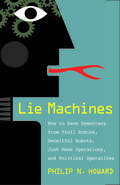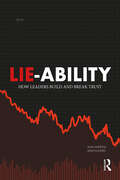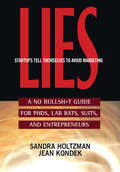- Table View
- List View
Liderazgo: Mejore Sus Habilidades De Comunicación Y Gestione Eficazmente El Equipo
by Jon GoldEste libro contiene pasos y estrategias comprobadas sobre cómo motivar y administrar eficazmente a su equipo de empleados. Entonces, ¿qué me califica para escribir un libro sobre liderazgo ...? Creo que lo más importante es mi permanencia en el ejército británico, hasta el día de hoy he prestado servicio durante más de ocho años. Durante estos años he realizado una gira por Afganistán y muchos, muchos ejercicios. Me uní al ejército en ... Usted tiene el rol de liderazgo ahora, ¿qué pasa después? Una vez que el líder se ha hecho cargo de un nuevo equipo, un equipo existente o se promueve desde dentro del equipo, la responsabilidad está en el nuevo líder. Hay una gran cantidad de información que un nuevo líder puede digerir para permitirle rendir al nivel esperado de rendimiento requerido por el gerente de la persona. Cómo un nuevo líder asimila la información y permite que su equipo se desempeñe al nivel esperado Si está listo para actuar y cambiar su vida para mejor, ¡este libro definitivamente lo guiará en la dirección correcta!
Liderazgo: Mejores Habilidades Para Convertirse En Un Líder Poderoso Y Motivar A La Gente
by Kravis NewmanPiénselo por un momento, muchas de las cosas que hacemos todos los días tienen algo que ver con alguien que nos ha influido de una manera u otra. Puede ser un padre, maestro, jefe, presidente o cualquier otra persona que hayas conocido o con quien te hayas enterado. Esto simplemente significa que, sea lo que sea que haya aprendido, de quienquiera que fue realmente transformador. Esto es lo que hacen los líderes; inculcan valores y enseñanzas en sus seguidores para que las ideologías que encarnan se transmitan a sus seguidores años, décadas o incluso siglos después de su desaparición. "Asegure su capa" describe cómo uno puede inspirarse en personajes no ficticios y ficticios. Se trata de inspirar a las mujeres que enfrentan desafíos como trabajar más de 40 horas por semana, cuidar de sus hijos y administrar sus hogares. Se proporciona información sobre cómo enfrentar y superar esos desafíos cotidianos. Este libro trata sobre motivar a las mujeres para que alcancen sus metas, identificando primero sus pasiones y propósitos en la vida, y luego ganando la confianza para sobresalir más allá de su imaginación. Este libro también identifica cómo las mujeres pueden sobresalir como líderes en su vida personal y profesional; lectores inspiradores que se encuentran en esa encrucijada en sus vidas y están listos para cambiar y hacer una diferencia en sus propias vidas y en las vidas de otros a su alrededor. Si está listo para actuar y cambiar su vida para mejor, ¡este libro definitivamente lo guiará en la dirección correcta!
Liderazgo: Métodos Definitivos Para Tener Éxito Y Ser Un Maestro En La Comunicación
by Theo WadeLos principios básicos del liderazgo son los mismos en todas partes. Las personas son personas y liderarlos en un arte que puedes aprender (y en el que puedes ser bueno). Liderazgo: El Primer Paso te enseñará esos principios y te brindará el marco de referencia en el cual puedes volverte un líder efectivo y exitoso. Este libro se escribió para darte la oportunidad de explorar temas y asuntos sobre los que podrías no haber tenido la ocasión de considerar. En particular, el libro ayuda a desarrollar una perspectiva personal más fuerte y a entender el rol que un individuo puede tener con respecto a la ética y a los negocios. Serás guiado a un mejor entendimiento de la motivación requerida en la arena de negocios de hoy en día, y su ambiente ético en constante evolución. La intensidad de tu motivación para tener éxito impactará grandemente tu perspectiva ética, y te ayudará a moldear tu carrera.
Liderazgo: Sea Confiado E Inspire A La Gente
by Ronald TredgoldSi usted va a liderar a otros, estará a cargo de balancear las tareas y el personal que le ayudarán a alcanzar cada meta. Este E-Book se enfoca en este delicado balance y describe la esencia, corto y simple. Hay muchas discusiones y definiciones acerca de que se trata el liderazgo, enfocándome en usted asumiendo el rol de líder siendo la fuente. Si asume la fuente correctamente, el resto será fácil de cumplir. Me ocupo de las preguntas sobre qué, por qué, dónde y de qué manera, y le proporciono las herramientas para que usted se administre a si mismo y desde allí puede administrar a los demás. ¿A qué espera? No espere más. Deslice hacia arriba y cliquee sobre el botón comprar ahora para comenzar la travesía a la vida de sus sueños!
Liderazgo: Ser Mejores En La Comunicación, La Motivación Y La Influencia De Las Personas
by Brigid BerryEste libro constituye una guía imprescindible que contiene las ideas, conceptos y debates más importantes en relación al estudio y ejercicio del liderazgo. Incluye frases escritas por un amplio expectro de expertos internacionales. Se trata de un recurso básico para directivos y líderes de todo tipo de organizaciones e instituciones y también para estudiantes de economía, sociología y politicas. La serie What's in it for Schools ha sido elaborada por expertos para una audiencia de profesionales muy ocupados. Los libros presentan de una forma amena y relevante conocimientos destacables en materia educativa. ¿Qué es lo que te hace ser un buen líder? ¿Un buen liderazgo puede ayudar al sistema educativo a ser más efectivo? Este libro conciso y cercano examina el liderazgo de una manera práctica ayudando a los directivos, profesores y padres a afianzar su papel y responsabilidades y a afrontarlas de acuerdo a lo requerido por el sistema educativo.
Liderismo: Liderismo: La guía completa para influir, motivar y comunicarse efectivamente
by Harvard Shotton¿Qué lleva a ser un buen líder? Quizás Ud. ha sido promovido recientemente, o quizás es Ud. el jefe de una compañía o negocio. Quizás Ud. ha estado en una posición de liderazgo por un largo tiempo, ya sea en retail, la industria del servicio, producción, recursos humanos, educación, finanzas, una compañía de inversiones, o como un gerente de línea o supervisor directo. Las posibilidades son interminables. O quizás seas bastante nuevo en este rol de liderismo que a ti se te ha dado. De cualquier forma, nosotros podemos hacer de todo con algún consejo, ya sea para repasar tus habilidades de liderismo, ser recordado de principios importantes, o ya sea para apuntar en la dirección correcta cuando tú comienzas en este camino.
Lie Machines: How to Save Democracy from Troll Armies, Deceitful Robots, Junk News Operations, and Political Operatives
by Philip N. HowardTechnology is breaking politics—what can be done about it? Artificially intelligent &“bot&” accounts attack politicians and public figures on social media. Conspiracy theorists publish junk news sites to promote their outlandish beliefs. Campaigners create fake dating profiles to attract young voters. We live in a world of technologies that misdirect our attention, poison our political conversations, and jeopardize our democracies. With massive amounts of social media and public polling data, and in-depth interviews with political consultants, bot writers, and journalists, Philip N. Howard offers ways to take these &“lie machines&” apart. Lie Machines is full of riveting behind-the-scenes stories from the world&’s biggest and most damagingly successful misinformation initiatives—including those used in Brexit and U.S. elections. Howard not only shows how these campaigns evolved from older propaganda operations but also exposes their new powers, gives us insight into their effectiveness, and explains how to shut them down.
Lie-Ability: How Leaders Build and Break Trust
by Simon Jones Alan WatkinsBusiness success depends on the ability to build trust. Trusted brands succeed and sustain. Trusted leaders inspire followers, grow companies, revenues and futures. But sadly, deceit has infected business and become widespread. Far too many leaders now use their own "alternative facts", to mislead and misinform their customers, colleagues and communities. The skilfulness and ease with which some leaders now lie has become a Lie-Ability. And when customers stop trusting the products, services or the stories a leader tells, then the business suffers. If business leaders don’t lead a truth renaissance, we are all lost. People no longer trust politicians or the media. And many of the institutions and professions we used to turn to have also lost trust. The only people that can really save us now are business leaders. We need to become truth advocates and activists. We must re-establish a new norm where we tell the truth to ourselves, to our employees, to our shareholders, to our customers and to society at large. This book explores the 7 Deadly Lies that business tells itself, the 7 Dark Arts of Deception that are still used with monotonous regularity to manipulate the narrative. It offers C-suite leaders and senior managers a clear path out of deceit. It provides a solution to the Lie-Ability of some leaders by developing a deeper understanding of truth, how to reclaim it and how to build back trust.
Lieferantenkommunikation im Anlaufmanagement: Bestandteile und Wirkungszusammenhänge auf den Unternehmenserfolg (Supply Chain Management)
by Claudia GesellDie Informationsökonomik bietet schon lange Instrumente zur Analyse der wirtschaftlichen Fragen des Informationsaustausches. Wenig untersucht ist aber bislang das Kommunikationsverhalten. Das vorliegende Buch setzt genau daran an. Anstatt einseitig das Kommunikationsverhalten der beschaffenden Organisation oder das Kommunikationsverhalten der Lieferanten zu untersuchen, steht tatsächlich wechselseitige Kommunikation im Vordergrund. Dazu entwickelt die Verfasserin theoriegestützt ein Untersuchungsmodell für die Wirkungszusammenhänge – hat (verbesserte) Lieferantenkommunikation Auswirkungen auf den Beschaffungserfolg?
Lieferkettengesetz: Sorgfaltspflichten in der Supply Chain verstehen und umsetzen (essentials)
by Stefan ZeiselIm strategischen Beschaffungsmanagement gewinnen vermehrt ökologische und soziale Gesichtspunkte an Bedeutung. Das neue Gesetz über die unternehmerischen Sorgfaltspflichten zur Vermeidung von Menschenrechtsverletzungen in Lieferketten (Lieferkettengesetz) unterstreicht die Notwendigkeit für Unternehmen, sich mit den Pflichten der Corporate Social Responsibility (CSR) nicht nur im eigenen Unternehmen, sondern auch in der Supply Chain auseinanderzusetzen. Häufig fehlt es jedoch an einem Verständnis, wie die neuen Anforderungen umgesetzt werden können. Hier kann dieses Essential als Leitfaden dienen, um die fachspezifischen Kenntnisse zum Thema Nachhaltigkeit und CSR zu vertiefen. Es enthält Informationen zu vorhandenen gesetzlichen Regelungen und Richtlinien, wichtigen CSR-Risiken sowie Instrumenten zur Sicherstellung von nachhaltigen Lieferketten.
Lieferkettensorgfaltspflichtengesetz: Ein Überblick für Praktiker
by Roland Falder Constantin Frank-Fahle Peter PoleacovDieses Buch ist eine der ersten Publikationen zum neuen Lieferkettensorgfaltspflichtengesetz. Der praxisbezogene Überblick stellt im Wesentlichen die neu geschaffenen Unternehmenspflichten, die Kernaspekte des Gesetzes sowie die Umsetzung der Sorgfaltspflichten dar. Zudem wird das neue Gesetz in den Kontext vergleichbarer Gesetze in anderen Jurisdiktionen und zur geplanten EU-Richtlinie gebracht, um einen internationalen Einblick in die Materie zu gewährleisten.
Lies Start-Ups Tell Themselves to Avoid Marketing
by Sandra Holtzman Jean KondekSo you think you know marketing. Think again. Lies Start-ups Tell Themselves to Avoid Marketing uses the tough love approach to steer you clear of the pitfalls and self-deceptions that have been the undoing of many when confronted with the harsh realities of today's marketplace. Sandra Holtzman and Jean Kondek employ their combined 40+ years' worth of marketing savvy to cut through all the usual malarkey-and, let's face it, bullsh@#*-to give you a streamlined approach to successfully launching a product, service, or company. Better than a handbook, Lies Start-ups Tell Themselves provides 10 fast-track, step-by-step chapters for planning and implementing a successful marketing program that you can get started on TODAY. The writing is clear and concise, breaking down concepts into bite-sized, easy to grasp nuggets for today's busy audience. Moreover, each chapter is stand-alone and immediately actionable. It doesn't take a rocket scientist to understand the value of a well thought out marketing program. But carving your niche in the marketplace can be a daunting task. Lies Start-ups Tell Themselves to Avoid Marketing guides you through the pitfalls and challenges to a successful start-up or product launch.
Lies We Live By: Defeating Doubletalk and Deception in Advertising, Politics, and the Media
by Carl HausmanFirst Published in 2000. Routledge is an imprint of Taylor & Francis, an informa company.
Lies and Liars: How and Why Sociopaths Lie and How You Can Detect and Deal with Them
by Gini Graham ScottApproximately 12 million Americans, or one in twenty-five, are sociopaths. But what does this statistic mean? What exactly is a sociopath? What do they do to be labeled as such? And how many people are affected by them? While everyday lying has become acceptable and even socially necessary, it is often difficult to discover when someone is manipulating you through lies or other actions. Since a sociopath has no conscience, he or she feels no remorse about piling lie on top of lie until, eventually, the façade comes crashing down and he or she is exposed.When Dr. Scott was warned about a film producer she had hired, she confronted the woman, only to be fed explanations and excuses. Eventually, Scott found that she had been the victim of this sociopath for five years, along with many others. In this book, she delves into medical research on sociopaths as well as interviews with sociopaths and victims alike to provide a comprehensive picture of this mental disorder. Lies and Liars also includes information about:The types of lies told by sociopaths in different situationsThe relationships between sociopaths and victimsRecognizing when someone is lyingHow to deal with a suspected or discovered sociopathic liarThe odds are very high that you know a sociopath already, so figure out what signs to look for to prevent yourself or your loved ones being manipulated or harmed.
Lies, Damned Lies, and Science: How to Sort Through the Noise Around Global Warming, the Latest Health Claims, and Other Scientific Controversies
by Sherry SeethalerDon't get hoodwinked: make sense of news. . . and make smarter decisions for yourself, your family, and the world! Objective, balanced techniques for thinking about everything from diet and drugs to climate change. Identifying and getting past the biases of politicians, lobbyists, marketers. . . and even some scientific and medical professionals. By scientist Dr. Sherry Seethaler, one of the world's most respected and innovative science educators.
Life 2.0
by Rich Karlgaard“A delightful, and surprisingly moving, tale” -- Michael Lewis, bestselling author ofMoneyball “Karlgaard flies in with a companion concept to David Brooks’sOn Paradise Drive” -- Tom Wolfe “While counterintuitive to those on the conventional fast-track,Life 2. 0offers great promise to those who are open to personal innovation” -- Clayton Christensen, Professor, Harvard Business School “This fascinating treatise will make you think deeply, and may just give you the impetus to uproot” -- Tom Peters “An original and exhilarating look at options many Americans don’t realize are now open to them. ” -- James Fallows, national correspondent,The Atlantic Monthly “Not only will it widen the horizons of your life, it could also renew your health and wealth. ” -- George Gilder Have You Found the Where of Your Happiness? One of the intriguing things about the United States is the idea of the second chance, that when you feel stuck there is always a frontier you can cross to reinvent yourself. InLife 2. 0, Rich Karlgaard used his own personal and professional midlife crises to look at the state of the American dream—the belief in continuous personal upward mobility—and where it stands in the twenty-first century. At the ripe old age of forty-five, Karlgaard fell in love with flying and mastered the art of lifting up and bringing down a “2,500-pound aluminum box kite”—a four-seat single-engine airplane. As the publisher of Forbes he felt that he was doing too much armchair theorizing and didn’t really understand how Americans were responding to the changes that had started taking place so swiftly over the past few years. So he put together his new flying skills and reportorial mission and flew around America to places like Green Bay, Wisconsin; Bozeman, Montana; Fargo, North Dakota; Des Moines, Iowa; and Lake Placid, New York, to gain some insight into how ordinary Americans are untangling the knotty problems of constant stress, crushing expense, and bewildering hassle that often characterize life in the nation’s urban centers. He discovered their simple solution: they moved. What Karlgaard found on the road are fascinating and inspiring stories about people— those with a nose for entrepreneurship, a faith in technology, and the willingness to take a chance—who are finding the new American dream in places as far from New York City and Silicon Valley as you can imagine. Some of those people include: • A burned-out insurance exec who fled his overworked East Coast life and settled in tranquil (yet dynamic) Des Moines • A tool broker who traded his brick-and-mortar business in sunny California for a life in the Pennsylvania hills, where he relaunched his business on the Internet • A road-warrior democracy specialist who conducts her worldly affairs from the low-key outpost of Bismarck, North Dakota • A self-made millionaire who paid for his financial success with his first marriage and who did things differently the second time around by moving to smaller cities and focusing on family as well as work Adroitly combining analysis of the economic and social trends challenging middle-class people with perceptive advice on how to escape the rat race of the coasts, Karlgaard explores the eye-opening possibilities of that huge tract of land often carelessly dubbed “flyover country. ” Filled with stories of personal reinvention and triumph, Life 2. 0 is the story of those who are living larger lives in smaller places. From the Hardcover edition.
Life 3.0: Being Human in the Age of Artificial Intelligence
by Max TegmarkNew York Times Best SellerHow will Artificial Intelligence affect crime, war, justice, jobs, society and our very sense of being human? The rise of AI has the potential to transform our future more than any other technology—and there&’s nobody better qualified or situated to explore that future than Max Tegmark, an MIT professor who&’s helped mainstream research on how to keep AI beneficial. How can we grow our prosperity through automation without leaving people lacking income or purpose? What career advice should we give today&’s kids? How can we make future AI systems more robust, so that they do what we want without crashing, malfunctioning or getting hacked? Should we fear an arms race in lethal autonomous weapons? Will machines eventually outsmart us at all tasks, replacing humans on the job market and perhaps altogether? Will AI help life flourish like never before or give us more power than we can handle? What sort of future do you want? This book empowers you to join what may be the most important conversation of our time. It doesn&’t shy away from the full range of viewpoints or from the most controversial issues—from superintelligence to meaning, consciousness and the ultimate physical limits on life in the cosmos.
Life After College
by Hundreds Of Heads Ricki Frankel Nadia Bilchik R. D. NortonNeed a job? An apartment? Insurance? A plan to pay for it all, without going into debt? Know how to cook and iron? And what ever happened to the weekend keg party? It seems like only yesterday that you were tossing your graduation cap in the air. Now, you're confronted with challenging real-world questions. There's no need to stress. Here's help. Hundreds of graduates help you navigate the real world with hard-won wisdom, tips, and advice. It's an orientation guide to becoming a successful, semi-mature adult. Life After College is the roommate every new college grad needs.Topics covered include:* Finding and Keeping Your Dream Job* Working Well with Bosses and Coworkers* The Perfect Place to Live - and How to Get There* Off-Campus Love* Cooking, Clothing, Etiquette - and Other Grown-Up Stuff* Is Grad School for You?* Savvy Advice on Budgeting - and Getting By with LessWith a special financial"how-to" guide from the American Institute for Economic Research.
Life After College: The Complete Guide to Getting What You Want
by Jenny BlakeLife After College is an essential manual for every graduating student and young professional. It features practical, actionable advice that helps people focus on the BIG picture of their lives, not just the details. Life After College will leave you feeling inspired, confident and ready to take action toward creating the life you really want. In Life After College Twitter meets What Color is Your Parachute for 20-somethings. Written by popular blogger and life coach Jenny Blake, Life After College provides tips, inspirational quotes and coaching exercises for every area of life including: Work, Money, Home, Organization, Friends & Family, Dating & Relationships, Health, Fun & Relaxation, and Personal Growth. The book is like having a portable life coach by your side -- it is a "one stop shop" that is part journal, part motivator, and part guidebook. Life After College is a powerful life-planning tool that no twenty-something will want to be without!
Life After Debt
by Joseph E. Stiglitz Daniel HeymannThis volume provides a pluralistic discussion from world-renowned scholars on the international aspects of the debt crisis and prospects for resolution. It provides a comprehensive evaluation of how the debt crisis has impacted Western Europe, the emerging markets and Latin America, and puts forward different suggestions for recovery.
Life After Google: The Fall of Big Data and the Rise of the Blockchain Economy
by George Gilder“Google’s algorithms assume the world’s future is nothing more than the next moment in a random process. George Gilder shows how deep this assumption goes, what motivates people to make it, and why it’s wrong: the future depends on human action.” — Peter Thiel, founder of PayPal and Palantir Technologies and author of Zero to One: Notes on Startups, or How to Build the Future. “If you want to be clued in to the unfolding future, then you have come to the right place. For decades, George Gilder has been the undisputed oracle of technology’s future. Are giant companies like Google, Amazon, and Facebook the unstoppable monopolistic juggernauts that they seem, or are they dysfunctional giants about to be toppled by tech-savvy, entrepreneurial college dropouts?” — Nick Tredennick, Ph.D., Chief Scientist, QuickSilver Technolog Silicon Valley’s Nervous Breakdown The Age of Google, built on big data and machine intelligence, has been an awesome era. But it’s coming to an end. In Life after Google, George Gilder—the peerless visionary of technology and culture—explains why Silicon Valley is suffering a nervous breakdown and what to expect as the post-Google age dawns. Google’s astonishing ability to “search and sort” attracts the entire world to its search engine and countless other goodies—videos, maps, email, calendars….And everything it offers is free, or so it seems. Instead of paying directly, users submit to advertising. The system of “aggregate and advertise” works—for a while—if you control an empire of data centers, but a market without prices strangles entrepreneurship and turns the Internet into a wasteland of ads. The crisis is not just economic. Even as advances in artificial intelligence induce delusions of omnipotence and transcendence, Silicon Valley has pretty much given up on security. The Internet firewalls supposedly protecting all those passwords and personal information have proved hopelessly permeable. The crisis cannot be solved within the current computer and network architecture. The future lies with the “cryptocosm”—the new architecture of the blockchain and its derivatives. Enabling cryptocurrencies such as bitcoin and ether, NEO and Hashgraph, it will provide the Internet a secure global payments system, ending the aggregate-and-advertise Age of Google. Silicon Valley, long dominated by a few giants, faces a “great unbundling,” which will disperse computer power and commerce and transform the economy and the Internet. Life after Google is almost here. For fans of "Wealth and Poverty," "Knoweldge and Power," and "The Scandal of Money."
Life After Law: Finding Work You Love with the J.D. You Have
by Liz Brown Gloria LarsonWritten by Harvard-trained ex-law firm partner Liz Brown, Life After Law: Finding Work You Love with the J.D. You Have provides specific, realistic, and honest advice on alternative careers for lawyers. Unlike generic career guides, Life After Law shows lawyers how to reframe their legal experience to their competitive advantage, no matter how long they have been in or out of practice, to find work they truly love. Brown herself moved from a high-powered partnership into an alternative career and draws from this experience, as well as that of dozens of former practicing attorneys, in the book. She acknowledges that changing careers is hard much harder than it was for most lawyers to get their first legal job after law school but it can ultimately be more fulfilling for many than a life in law. Life After Law offers an alternative framework and valuable analytic tools for potential careers to help launch lawyers into new fields and make them attractive hires for non-legal employers.
Life After Law: Finding Work You Love with the J.D. You Have
by Liz BrownWritten by Harvard-trained ex-law firm partner Liz Brown, Life After Law: Finding Work You Love with the J.D. You Have provides specific, realistic, and honest advice on alternative careers for lawyers. Unlike generic career guides, Life After Law shows lawyers how to reframe their legal experience to their competitive advantage, no matter how long they have been in or out of practice, to find work they truly love. Brown herself moved from a high-powered partnership into an alternative career and draws from this experience, as well as that of dozens of former practicing attorneys, in the book. She acknowledges that changing careers is hard much harder than it was for most lawyers to get their first legal job after law school but it can ultimately be more fulfilling for many than a life in law. Life After Law offers an alternative framework and valuable analytic tools for potential careers to help launch lawyers into new fields and make them attractive hires for non-legal employers.
Life After Residency: Increase Your Brain's Creativity, Energy, And Focus
by Melissa T. Berhow William W. Feaster John G. Brock-UtneLife After Residency: A Career Planning Guide is an insightful, step-by-step guide to achieving a successful and fulfilling career in medicine. As professors at Stanford University Medical Center, Drs. Melissa Berhow, William Feaster, and John Brock-Utne began running seminars to advise their residents not only on creating a curriculum vitae and landing a great job, but also on how to manage student loan payments and avoid pitfalls in the life of a physician. The immense success and ensuing demand for more seminars eventually gave rise to Life After Residency--a book which continues the seminar discussions in greater depth and magnitude, while maintaining a conversational writing style. Key topics covered include: preparing for a job interview, evaluating job offers and negotiating contracts, obtaining and maintaining the proper State license, applying for membership onto Medical Staffs, obtaining malpractice insurance, buying a house and investing for eventual retirement, and pursuing non-medical career options. Loaded with sage advice and practical wisdom, Life After Residency is an invaluable asset to every resident during the transition from residency to life thereafter.
Life After... Social Studies: A Practical Guide to Life After Your Degree
by Sally LongsonThousands of students graduate from university each year. The lucky few have the rest of their lives mapped out in perfect detail – but for most, things are not nearly so simple. Armed with your hard-earned degree the possibilities and career paths lying before you are limitless, and the number of choices you suddenly have to make can seem bewildering. Life After ... Social Studies has been written specifically to help students currently studying, or who have recently graduated, make informed choices about their future lives. It will be a source of invaluable advice and wisdom to business graduates (whether you wish to use your degree directly or not), covering such topics as: Identifying a career path that interests you Seeking out an opportunity that matches your skills and aspirations Staying motivated and pursuing your goals Networking and self-promotion Making the transition from scholar to worker Putting the skills you have developed at university to good use in life. The Life After ... series of books are more than simple ‘career guides’. They are unique in taking a holistic approach to career advice - recognising the increasing view that, although a successful working life is vitally important, other factors can be just as essential to happiness and fulfilment. They are the indispensable handbooks for students considering their future direction.
























